Holy Communion Meaning in Bible: Unity and Remembrance
Holy Communion, known as the Eucharist, is a pivotal sacrament that originates from the Biblical account of the Last Supper, where Jesus Christ shared bread and wine with His disciples, symbolizing His body and blood (Matthew 26:26-28). This ritual, documented in the Synoptic Gospels and expounded upon in 1 Corinthians 11:23-26, signifies the establishment of a new covenant, the remembrance of Christ’s sacrifice, and the promise of salvation.
It encourages unity and spiritual nourishment among believers. Exploring this tradition further reveals its rich theological and symbolic dimensions across various Christian denominations.
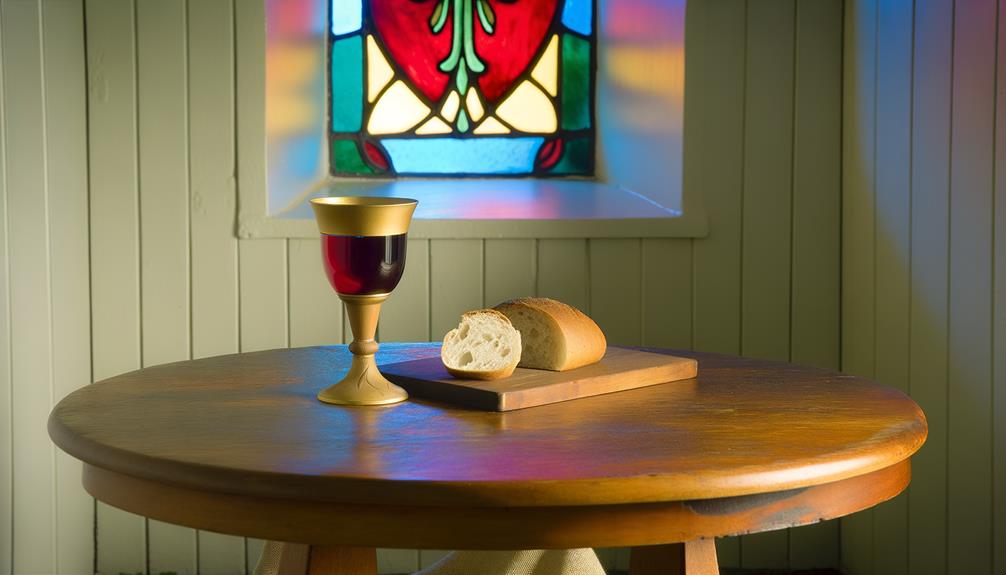
Holy Communion Meaning in the Bible: Symbolism of Sacrifice, Unity, and Thanksgiving
| Aspect | Biblical Meaning |
|---|---|
| Remembrance of Christ’s Sacrifice | Holy Communion, also known as the Lord’s Supper, is a ritual that commemorates Jesus Christ’s sacrifice on the cross. It reflects His body broken and His blood shed for the forgiveness of sins (Luke 22:19-20). |
| Symbol of New Covenant | The act of taking Communion symbolizes the New Covenant established by Christ, signifying the promise of salvation, grace, and eternal life through His blood (1 Corinthians 11:25). |
| Spiritual Nourishment & Unity | Partaking in Communion is seen as receiving spiritual nourishment. It represents the believer’s unity with Christ and fellowship with other believers, forming one body in faith (1 Corinthians 10:16-17). |
| Act of Thanksgiving | Holy Communion is also an act of thanksgiving, expressing gratitude for God’s love, grace, and the gift of salvation through Jesus. The term “Eucharist,” another name for Communion, comes from the Greek word for thanksgiving (Matthew 26:26-27). |
| Examination & Repentance | Before partaking, believers are encouraged to examine themselves, confess their sins, and approach the table with reverence. It serves as a reminder of the importance of repentance and living in alignment with Christ’s teachings (1 Corinthians 11:28-29). |
The Last Supper
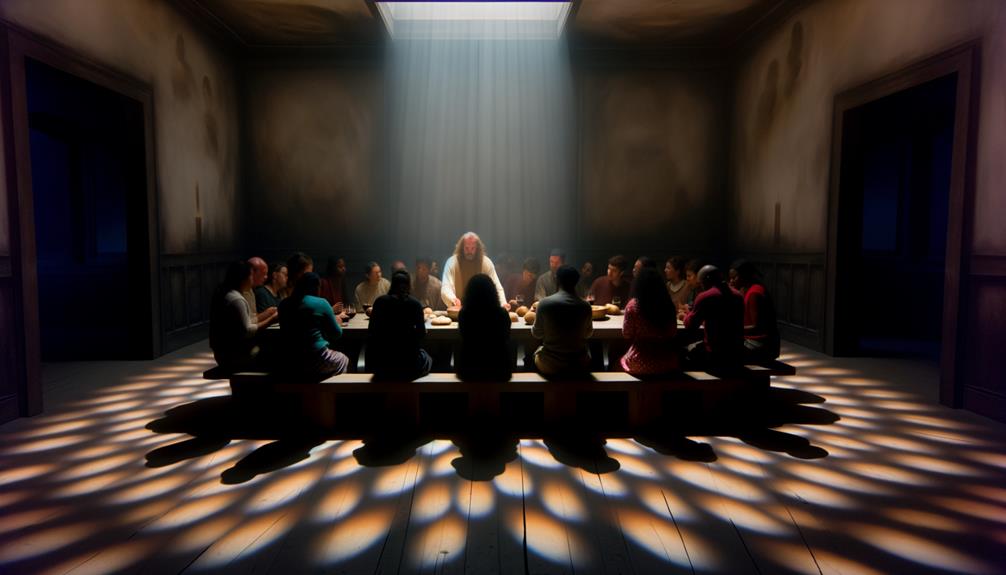
The Last Supper, a pivotal event in Christian theology, marks the final meal Jesus shared with his disciples before his crucifixion, serving as the foundation for the sacrament of Holy Communion. This event is not merely a historical account but a theological cornerstone that encapsulates themes of sacrifice, fellowship, and covenant.
During this meal, Jesus instituted the practice of breaking bread and sharing wine, symbolically representing His body and blood, thereby prefiguring His imminent sacrifice. The Last Supper underscores the shift from the old covenant to the new, emphasizing the continuity and fulfillment of scriptural promises.
Its liturgical reenactment in Holy Communion serves as a perpetual reminder of Christ’s sacrificial love and the communal bond among believers.
Biblical Origins

Scriptural foundations of Holy Communion trace back to the narratives found in the Synoptic Gospels and Paul’s First Epistle to the Corinthians. These texts collectively underscore the institution of this sacrament by Jesus during the Last Supper, emphasizing its theological significance and ritualistic praxis.
The Synoptic Gospels (Matthew, Mark, and Luke) provide detailed accounts of Jesus breaking bread and sharing wine with His disciples, while 1 Corinthians 11:23-26 offers Paul’s theological reflection and apostolic instruction on the practice.
Key elements include:
- Institution by Jesus: Jesus’ words and actions during the Last Supper.
- Apostolic Tradition: Paul’s recounting and theological exposition.
- Covenantal Context: Establishment of a new covenant through Jesus’ sacrifice.
Symbolism of Bread
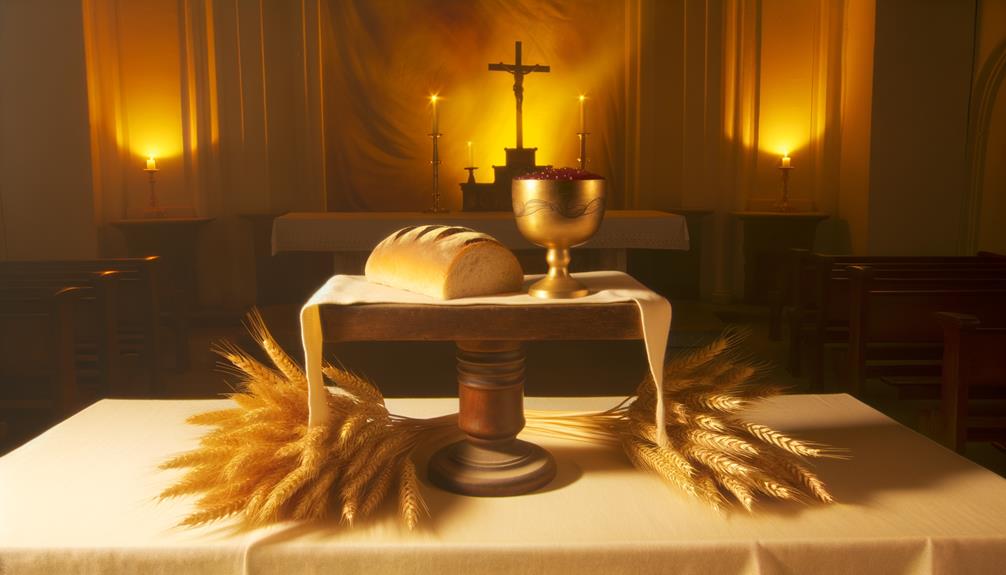
In the context of Holy Communion, bread symbolizes the body of Christ, serving as a tangible representation of His sacrificial offering and a means for believers to partake in the mystery of the Eucharist.
This symbolism is deeply rooted in scriptural passages such as the Last Supper narratives (e.g., Matthew 26:26), where Jesus breaks bread, declaring, ‘This is my body.’
The sharing of bread signifies unity within the body of Christ, fostering a communal bond among believers.
Additionally, it serves as a reminder of the incarnation—the Word becoming flesh.
Hence, the bread is not merely a historical artifact but a profound element of Christian liturgy, embodying theological and spiritual dimensions pivotal to the faith.
Symbolism of Wine

The wine in Holy Communion serves as a profound symbol of Jesus’ blood, embodying themes of covenant and redemption.
It signifies the new covenant between God and humanity, established through Christ’s sacrificial act.
In addition, it represents the ultimate redemption, offering believers a tangible connection to the spiritual promise of salvation.
Representation of Jesus’ Blood
Wine, as a symbol during the Holy Communion, embodies the profound theological concept of Jesus’ sacrificial blood shed for the remission of sins. This representation carries deep biblical significance, rooted in Jesus’ words during the Last Supper: ‘This is my blood of the covenant, which is poured out for many for the forgiveness of sins’ (Matthew 26:28).
The symbolism of wine in this setting signifies:
- Atonement: The cleansing of humanity’s sins through Christ’s sacrifice.
- Unity: Binding believers together in the shared act of Communion.
- Life: Representing the new life given through Jesus’ sacrifice.
This rich symbolism emphasizes the transformative power of Jesus’ sacrifice.
Covenant and Redemption Symbol
Central to the symbolism of wine in Holy Communion is its representation of the covenant between God and humanity, underscoring the profound themes of redemption and divine promise. The wine signifies the blood of Christ, shed for the remission of sins, thereby establishing a new covenant. This act is rooted in the Last Supper, where Jesus declared the wine as His blood of the covenant (Mark 14:24). This symbolic gesture reaffirms the promise of salvation and eternal life through faith in Christ.
| Symbol | Representation | Biblical Reference |
|---|---|---|
| Wine | Blood of the Covenant | Mark 14:24 |
| Wine | Redemption | Ephesians 1:7 |
| Wine | Divine Promise | Hebrews 9:15 |
In this context, wine becomes a powerful emblem of spiritual renewal and divine assurance.
Paul’s Teachings
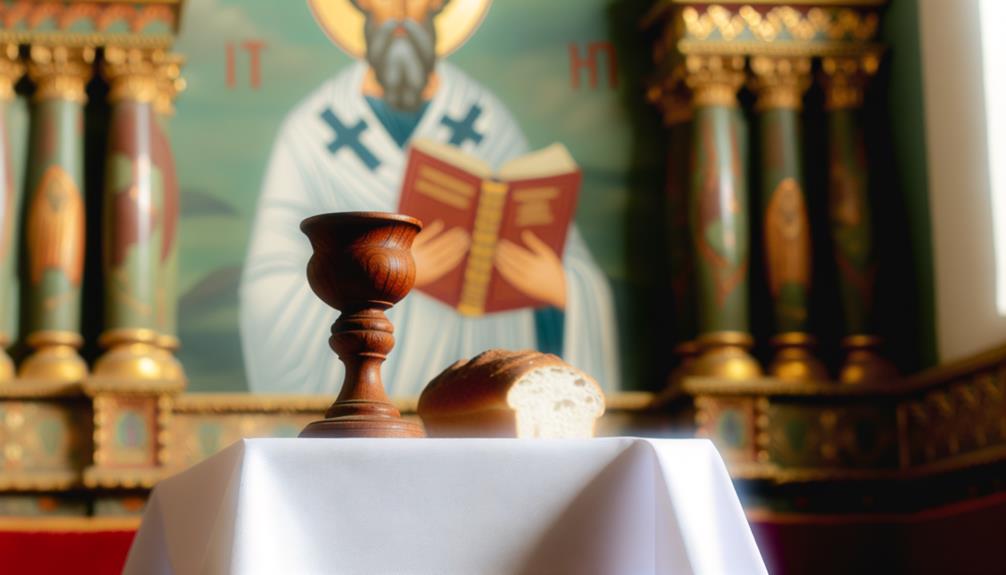
Paul’s teachings on Holy Communion offer profound theological insights that underscore the sacrament’s significance within early Christian communities. His epistles, particularly 1 Corinthians 11:23-26, emphasize the sacrament as a memorial of Christ’s sacrificial death and a proclamation of His return.
Paul also addresses the proper disposition of the participants, stressing the need for self-examination and reverence.
- Sacrament as Memorial: Paul underscores that Holy Communion serves as a remembrance of Jesus Christ’s sacrifice.
- Proclamation of Christ’s Return: The act of taking Communion is a declaration of faith in Jesus’ second coming.
- Self-examination: Participants are urged to examine themselves to partake worthily.
Unity in Communion
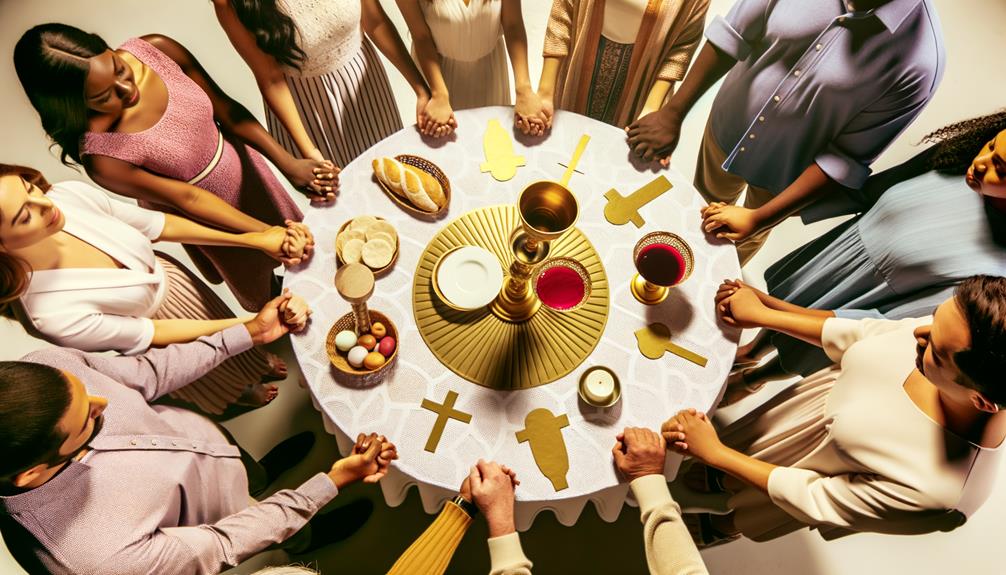
In addition to emphasizing the sacramental and commemorative aspects of Holy Communion, Paul’s teachings also highlight its role in fostering unity among believers.
In 1 Corinthians 10:17, Paul states, ‘Because there is one bread, we who are many are one body, for we all partake of the one bread.’ This metaphorical assertion underscores the communal dimension of the Eucharist, symbolizing the collective participation in Christ’s body and blood.
The shared act of communion serves to dissolve divisions and cultivate a sense of shared identity and purpose within the Christian community.
Consequently, Holy Communion becomes not merely a ritual but a profound expression of ecclesial unity, aligning individual believers with the broader body of Christ.
Remembrance of Christ
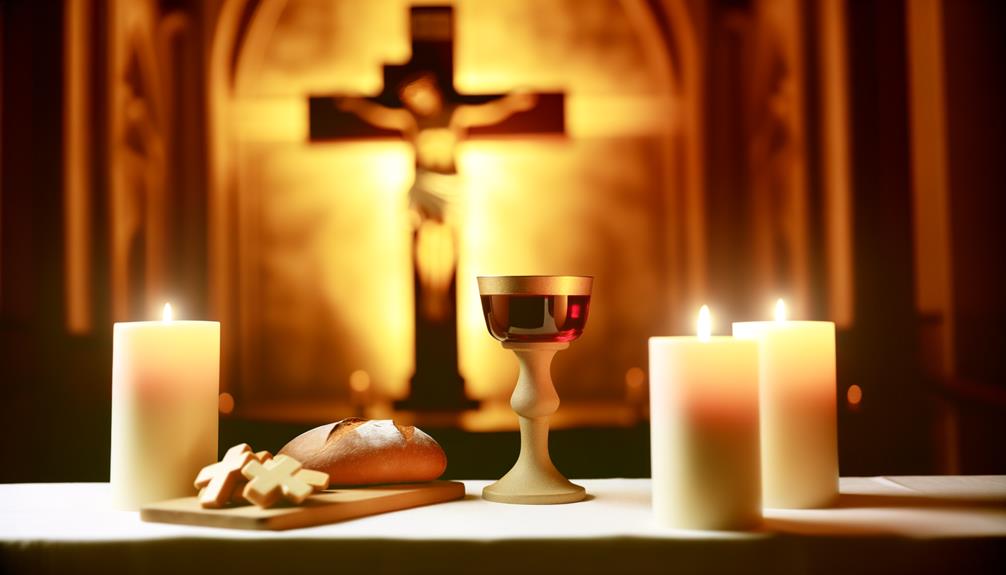
The act of Holy Communion serves as a poignant remembrance of Christ’s sacrificial death and the New Covenant established through His blood. This sacred practice, deeply rooted in Christian tradition, reflects the profound theological implications of Jesus’ Last Supper with His disciples. It involves the partaking of bread and wine, symbolizing Christ’s body and blood, respectively.
Biblical Foundation: Derived from Jesus’ words in Luke 22:19-20, commanding His followers to remember Him.
Symbolism: Bread and wine are emblematic of Christ’s body and blood, signifying His ultimate sacrifice.
Covenantal Relationship: Reinforces the New Covenant, emphasizing the believers’ relationship with God.
Liturgical Practice: Integral to Christian worship, fostering spiritual reflection and communal unity.
This remembrance fosters a deep connection with Christ’s redemptive work.
Receiving Grace
Holy Communion is not merely a ritual of remembrance but also a means through which believers receive divine grace. This sacrament, rooted in biblical tradition, is viewed as a conduit for divine favor and spiritual enrichment.
The Apostle Paul, in 1 Corinthians 10:16, refers to the cup of blessing and the bread as a participation in the body and blood of Christ, indicating a profound spiritual encounter. This participation is understood to convey God’s grace, fortifying the believer’s faith and fostering a deeper union with Christ.
The theological foundation underscores that through this sacred act, believers are not passively recalling Christ’s sacrifice but actively engaging in a grace-filled communion with the divine, thereby experiencing transformative spiritual benefits.
Spiritual Nourishment

How does the sacrament of Holy Communion serve as a source of spiritual nourishment for believers?
Theologically, Holy Communion is integral for fostering a deep spiritual connection with Christ. It transcends mere ritual, providing profound spiritual sustenance. Scripturally anchored, it embodies several key elements:
- Union with Christ: Partaking in the Eucharist signifies a mystical union with Jesus, reflecting John 6:56.
- Strengthening Faith: Regular participation fortifies the believer’s faith, reinforcing their spiritual resolve.
- Community Bonding: It engenders a sense of unity within the Christian community, as seen in 1 Corinthians 10:17.
Thus, Holy Communion is pivotal for spiritual nourishment, grounding believers in their faith.
Contemporary Practice
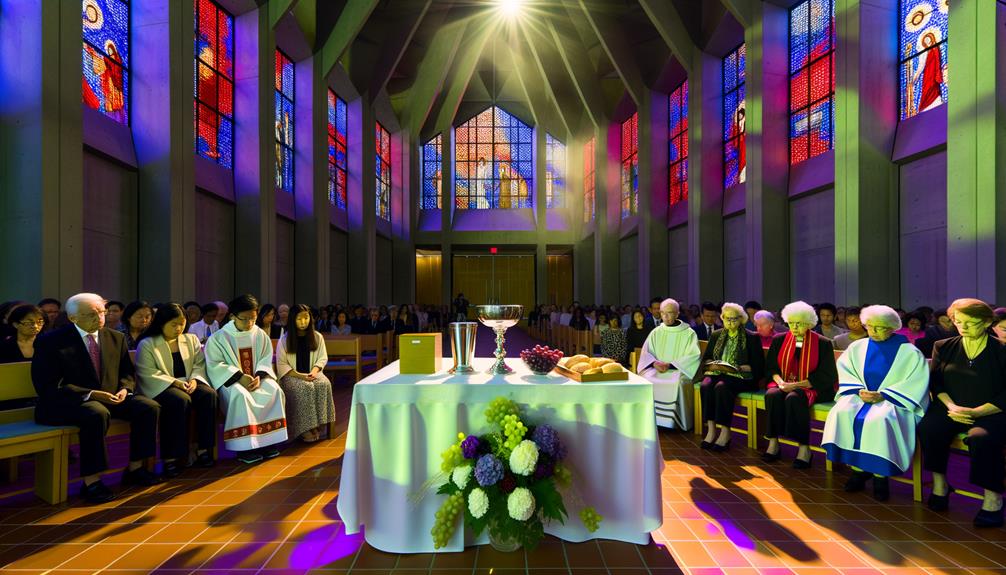
In examining contemporary practices of Holy Communion, it is imperative to contemplate the modern rituals observed, which vary widely across different church denominations.
These variations influence both the frequency and the theological significance attributed to the sacrament.
Modern Rituals Observed
The contemporary practice of Holy Communion incorporates a diverse range of rituals that reflect both traditional liturgical elements and modern adaptations tailored to various denominations and cultural contexts.
These practices are often designed to resonate with contemporary congregants while maintaining the sacramental essence of the Eucharist.
Modern rituals include:
- Use of alternative elements: Some communities opt for gluten-free bread or grape juice to accommodate dietary restrictions.
- Virtual Communion: With technological advancements, virtual communion services have become more prevalent, especially during global crises.
- Inclusivity in participation: Rituals are increasingly designed to be more inclusive, welcoming all who seek spiritual nourishment.
Church Denominations’ Differences
Diverse Christian denominations exhibit marked differences in their contemporary practices of Holy Communion, reflecting theological variances and cultural adaptations.
For instance, the Roman Catholic Church emphasizes transubstantiation, wherein the bread and wine become the actual body and blood of Christ.
Conversely, many Protestant denominations, such as Lutheran and Anglican, hold to consubstantiation, viewing Christ’s presence as symbolic yet real.
The Methodist tradition often treats Communion as a means of grace, open to all believers, while Orthodox Christians observe it as a mystical participation in Christ’s sacrifice.
These distinctions underscore the multifaceted nature of Holy Communion, shaped by centuries of doctrinal development and cultural influences, revealing the profound diversity within Christianity’s unified aim of commemorating Christ’s Last Supper.
Frequency and Significance
Contemporary practices of Holy Communion across Christian denominations vary widely in both frequency and the perceived significance of the sacrament. For some, it is a weekly observance, while others partake monthly, quarterly, or even annually. The theological emphasis also diverges, reflecting distinct doctrinal beliefs.
- Roman Catholic Church: Typically celebrates Communion during every Mass, emphasizing the real presence of Christ.
- Protestant Denominations: Frequency ranges from weekly in some traditions (e.g., Anglican, Lutheran) to less frequent in others (e.g., Baptist).
- Eastern Orthodox Church: Administers Communion at every Divine Liturgy, underscoring its sacramental mystery.
These variations underscore the multifaceted nature of contemporary Christian worship and theological reflection.
Conclusion
In summation, Holy Communion, rooted in the Last Supper, intertwines profound biblical symbolism and theological significance. Holy Communion serves as a memorial of Jesus’ sacrificial death and resurrection, as well as a means of grace for believers. The elements of bread and wine, representing the body and blood of Christ, also convey the holy trinity meaning, signifying the Father, Son, and Holy Spirit present in the act of communion. This practice holds a central place in many Christian traditions, affirming the unity of believers and their ongoing participation in the life of Christ.
The bread and wine serve as tangible emblems of Christ’s body and blood, fostering a sacred remembrance of His sacrifice.
Paul’s teachings further elucidate this rite as a conduit for divine grace and spiritual nourishment.
This venerable practice endures in contemporary Christian worship, a perpetual witness to the enduring legacy of Christ’s covenant with humanity, resonating through the ages like an eternal hymn.






